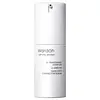What's inside
What's inside
 Key Ingredients
Key Ingredients

 Benefits
Benefits

 Concerns
Concerns

 Ingredients Side-by-side
Ingredients Side-by-side

Water
Skin ConditioningGlycerin
HumectantCyclopentasiloxane
EmollientNiacinamide
SmoothingDimethicone
EmollientButylene Glycol
HumectantAluminum Starch Octenylsuccinate
AbsorbentPentylene Glycol
Skin ConditioningTrehalose
HumectantHydroxyethyl Acrylate/Sodium Acryloyldimethyl Taurate Copolymer
Emulsion StabilisingPolymethyl Methacrylate
Phenoxyethanol
PreservativeCetearyl Dimethicone Crosspolymer
Bisabolol
MaskingChlorphenesin
AntimicrobialGlyceryl Polyacrylate
Disodium EDTA
Sodium Hydroxide
BufferingParfum
Masking1,2-Hexanediol
Skin ConditioningCaprylyl Glycol
EmollientTranexamoyl Dipeptide-23
BleachingAlpha-Arbutin
AntioxidantLeontopodium Alpinum Extract
Skin ConditioningCitric Acid
BufferingPotassium Sorbate
PreservativeSodium Benzoate
MaskingWater, Glycerin, Cyclopentasiloxane, Niacinamide, Dimethicone, Butylene Glycol, Aluminum Starch Octenylsuccinate, Pentylene Glycol, Trehalose, Hydroxyethyl Acrylate/Sodium Acryloyldimethyl Taurate Copolymer, Polymethyl Methacrylate, Phenoxyethanol, Cetearyl Dimethicone Crosspolymer, Bisabolol, Chlorphenesin, Glyceryl Polyacrylate, Disodium EDTA, Sodium Hydroxide, Parfum, 1,2-Hexanediol, Caprylyl Glycol, Tranexamoyl Dipeptide-23, Alpha-Arbutin, Leontopodium Alpinum Extract, Citric Acid, Potassium Sorbate, Sodium Benzoate
Ingredients Explained
These ingredients are found in both products.
Ingredients higher up in an ingredient list are typically present in a larger amount.
Butylene Glycol (or BG) is used within cosmetic products for a few different reasons:
Overall, Butylene Glycol is a safe and well-rounded ingredient that works well with other ingredients.
Though this ingredient works well with most skin types, some people with sensitive skin may experience a reaction such as allergic rashes, closed comedones, or itchiness.
Learn more about Butylene GlycolChlorphenesin is a synthetic preservative. It helps protect a product against bacteria in order to extend shelf life. In most cases, Chlorphenesin is paired with other preservatives such as phenoxyethanol and caprylyl glycol.
Chlorphenesin is a biocide. This means it is able to help fight the microorganisms on our skin. It is also able to fight odor-releasing bacteria.
Chlorphenesin is soluble in both water and glycerin.
Studies show Chlorphenesin is easily absorbed by our skin. You should speak with a skincare professional if you have concerns about using Chlorphenesin.
Learn more about ChlorphenesinDisodium EDTA plays a role in making products more stable by aiding other preservatives.
It is a chelating agent, meaning it neutralizes metal ions that may be found in a product.
Disodium EDTA is a salt of edetic acid and is found to be safe in cosmetic ingredients.
Learn more about Disodium EDTAPhenoxyethanol is a preservative that has germicide, antimicrobial, and aromatic properties. Studies show that phenoxyethanol can prevent microbial growth. By itself, it has a scent that is similar to that of a rose.
It's often used in formulations along with Caprylyl Glycol to preserve the shelf life of products.
Water. It's the most common cosmetic ingredient of all. You'll usually see it at the top of ingredient lists, meaning that it makes up the largest part of the product.
So why is it so popular? Water most often acts as a solvent - this means that it helps dissolve other ingredients into the formulation.
You'll also recognize water as that liquid we all need to stay alive. If you see this, drink a glass of water. Stay hydrated!
Learn more about Water